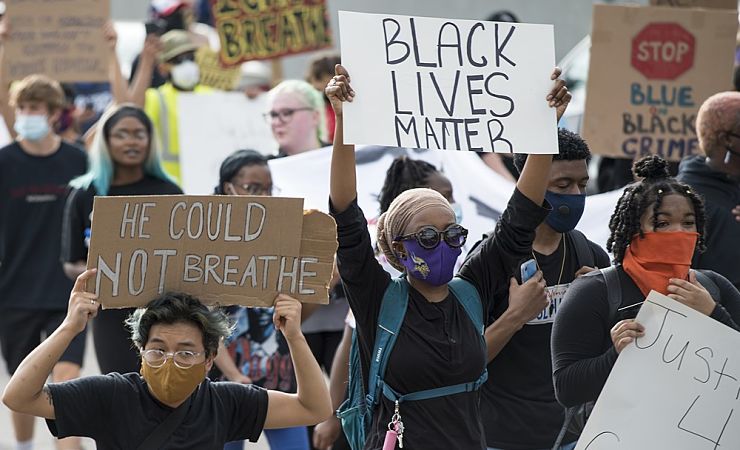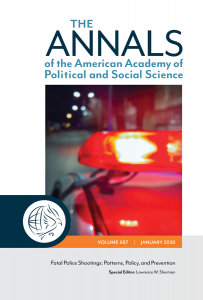Article Collection Examines How to Prevent Police Killings
The January 2020 volume of The ANNALS of the American Academy of Political and Social Science centered on current social and behavioral research on reducing deaths when law enforcement interacts with the public. Larry Sherman, a former president of the academy and director of the Cambridge Center for Evidence-Based Policing at Cambridge University, edited the volume, “Fatal Police Shootings: Patterns, Policy, and Prevention.” The recent police killings of Breonna Taylor and George Floyd have given new urgency to the unremitting issue, and we offer the articles in the volume to inform the actions of those working for a less-deadly future.
The volume doesn’t look at every aspect of police killings; issues of race, for example, are not directly addressed in this collection, and the focus is on death by firearms. It does, however, offer actionable and realistic suggestions for reducing the death toll immediately. This description of the volume, originally written for its release, serves as a guide to unlocking its value, highlighting some of its scholarship and linking to the pertinent articles.

Fatal police shootings of citizens are often described as unpreventable events caused by split-second decision-making. But the evidence shows that this description is problematic. As this volume of The ANNALS shows, describing fatal shootings as split-second decisions fails to consider the multiple causes and systems that generate decisions to shoot. This collection of work calls for a new kind of understanding about police decision-making: one that views many police shootings as preventable, views police departments as capable of reducing harm against both citizens and officers, and views state legislatures and health care policy as key tools to help police save lives. The scholarship presented here suggests that reducing violent citizen-police encounters requires broad theoretical explanations of interactions, persons, and organizations; deep data collection; and field experiments in new systems and policies.
Key takeaways from the research articles are listed at the bottom of this summary.
The articles in the volume address key questions about fatal police encounters. What patterns can be found in the data on police shootings? How does existing policing policy influence fatal shootings? What strategies does research suggest might lower fatalities and strengthen police legitimacy? The volume includes a summary paper from the special editor, Lawrence Sherman, in which he draws out recommendations from the papers, and an essay from Laurie Robinson—co-chair of President Obama’s Task Force on 21st Century Policing—that reflects on the value of the collection.
Signal contributions of the volume:
Detailed descriptions of patterns of fatal police shootings, some never previously reported and none of them widely known. New empirical findings and insights are presented throughout the volume, showing, for example, that the individual characteristics of officers and their behaviors (e.g., age of officers at recruitment, race, prior problem behavior, and prior arrest histories) can strongly correlate to their propensity to shoot civilians; that the proliferation of guns in specific communities correlates to higher rates of police shootings; that there is a higher likelihood of deaths from officer shootings when access to trauma centers is more remote; that officers who are concerned about appearing to be racist have higher likelihoods of using force in racially discriminatory ways; and that African American officers in one large U.S. police department are three times more likely to shoot than white officers.
Interwoven with specific research findings are demonstrations of the ways in which academic theory can help us to understand fatal police encounters. For example, one article reframes police shootings as broad systemic failures, explaining that bad outcomes are likely to occur in situations that are highly complex with interdependent technical and human interactions—police/civilian encounters are just such situations. Another article shows that police violence can be understood through the application of social psychology (e.g., how officers’ self-image and standing influence their responses to threat), and social network theory (e.g., work on the Chicago P.D. shows an association between the social networks of officers and shooting at civilians—specifically that officers who shoot tend to be key points of connection among different social networks within a department).
A comprehensive critique of current and recommended police policies shaping fatal police shootings: What we do know and don’t know.
Controversial incidents involving uses of force by police in recent years has led to widespread support for body-worn cameras, de-escalation training, implicit bias training, early intervention systems, and civilian oversight. Many such policies are often ambiguously defined. Others lack empirical evidence that would support their implementation. The authors outline a number of evidence-based approaches that promise to improve policing practice. The evidence includes a deeper qualitative appreciation of implementing new policies, even with methods as basic as mid-career police training. These policies include general training in social interaction skills, which may work better than a vague mandate in many states to provide training in “de-escalation” skills. For example, to reduce violent interactions between officers and people in behavioral crisis, officers can use gun violence restraining orders in many states, a legal power that research shows to be generally under-utilized.
Guidance to prevent avoidable fatalities of citizens and police based on both evidence and theory. This guidance includes the prospects for saving lives by immediate police transport to the hospital of persons wounded by gunfire. Some evidence suggests that such a policy may increase survival rates. Theory suggests it may improve perceptions of police in communities with low trust in police. Even the ways in which police chiefs apologize or express regret for fatalities can be guided by both evidence and theory. But the evidence is still far too weak about a problem causing some 1,000 fatalities a year, including both police and citizens. A stronger apparatus for state and federal research is needed.
Collaboration between academia and law enforcement is also essential. Findings from technical articles can influence policy and practice only if academic work can be effectively translated for and presented to police chiefs and policy-makers. Throughout the volume, but particularly in the special editor’s concluding essay, there are useful summaries of authors’ insights on how evidence-based approaches can improve policing practice and policy.
This ANNALS volume shows how and why police shootings in America is a solvable problem. Much of the problem is understandable and some of the solutions can be implemented right now: we give those explanations. Much of the work remains to be done, and we explain how to do it.
Reducing fatal encounters will require going beyond traditional methods of targeting, testing, and tracking police actions. It will require the re-engineering of police-citizen encounters, with a “safety first” priority. That agenda requires that we use theory to better understand police fatalities and the systems that produce them—especially the body of thought called “normal accident theory” in the tradition of the late Charles Perrow, which frames the entire volume. Perhaps most importantly, researchers, practitioners, and policy-makers can work together to lower police fatal shootings.
Key takeaways from the research articles
• Fatal police shootings are higher in states with more guns per household (Nagin)
• Fatal police shootings are higher in states with less local trauma care (Nagin)
• NYPD officers who make the most minor crime arrests are less likely to shoot when others do (Ridgeway)
• Chicago officers with more citizen complaints lodged against them shoot more often than others; shooting risk spreads when high-complaint officers are transferred (Zhao & Papachristos)
• Officers with less secure masculinity are more likely to pull the trigger in simulations (Goff)
• Mental health innovations could reduce fatal police shootings (Pollack & Humphreys)
• Police rapid transport of shooting victims to hospital could save lives (Jacoby et al.)
• SWAT team veteran: better tactical systems can reduce police shootings (Klinger)
• “Red flag laws” with instant gun seizure could reduce fatal shootings (Sherman)
• Small increase to federal research budget could reduce fatal police shootings (Zimring)
• Apologies may backfire unless police chiefs accept responsibility (O’Brien et al.)
• Few police chiefs will read this volume; better outreach is needed (Robinson)
Click here to view an hour-long webinar based on The ANNALS volume.

































































































